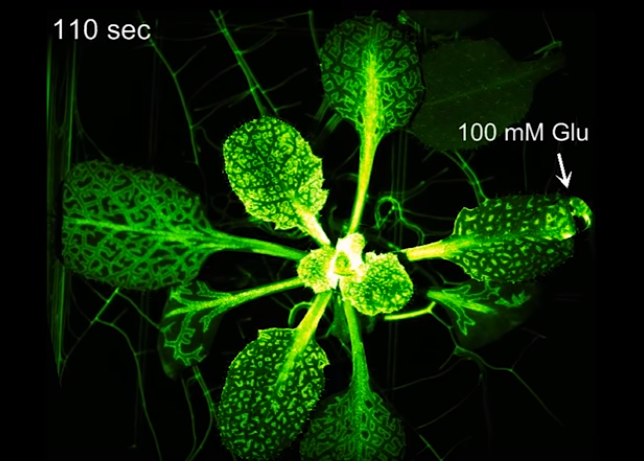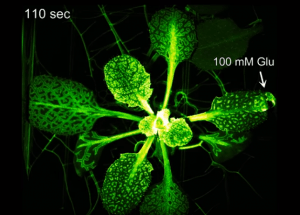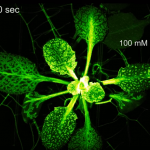
Calcium propagating across the plant after supplying glutamate at the tip of the leaf. Image taken from the video of Toyota, Gilroy, et al. depicting one of the data from their recent study on a mutant Arabidopsis.
Table of Contents
When herbivore, such as an insect, nibbles a plant leaf, the plant sets off an “SOS” or distress signal as one of the various plant defense strategies. This was based on what a team of researchers headed by Masatsugu Toyota observed. Accordingly, the injured leaf makes the distant undamaged leaves aware that it is being eaten.
Masatsugu Toyota worked with Simon Gilroy, Professor of Botany in the University of Wisconsin-Madison.1 Now, Toyota is at Saitama University in Japan and collaborated with a team of researchers from the Japan Science and Technology Agency, Michigan State University, and the University of Missouri. Their research findings can be accessed online via the journal Science. 2
Rapid signaling in plant defense mechanism
Previously, Toyota et al. knew that when a plant gets wounded, it releases signaling molecules that fired an electrical charge, and then spread across the plant. However, they did not know what was behind the system.3 Now, the research team deduced that the signal may have been calcium since it carries a charge, and capable of producing such a signal. 1
The research team worked on a mutant Arabidopsis. They designed a mutant model plant that would synthesize a protein that fluoresces, but only around calcium. In so doing, they can track calcium in real-time.
Plant defense involving glutamate
In spite of the fact that the plants lack the nerves and a nervous system of an animal, the plants have a fairly similar systemic signaling system as part of plant defense mechanisms.
In animals, glutamate acts as one of the major and fast excitatory neurotransmitters of the central nervous system. Toyota et al. elucidated that, in plants, glutamate is also present. The injured leaf releases glutamate and this molecule is taken up by glutamate-receptor-like ion channels. Consequently, these ion channels led to a spike in calcium ion concentration. These calcium ions, then, spread out to other plant parts via the phloem vasculature and the plasmodesmata. 2
This video from UW-Madison Campus Connection shows the wave of calcium after supplying glutamate to the tip of a leaf. The plant fluoresces to indicate how the calcium spreads out across the plant.
Distress signal
In just a couple of minutes, the region receiving the distress signal responds by releasing chemicals. The release of defense-related hormones, for instance, turns the plant unpalatable to the herbivore. In another case, the plant emits volatile chemicals to call for insect allies, such as parasitic wasps. This is an indirect type of a plant defense strategy. The wasps recognize the distress signal that an herbivore feeds on the plant. They, then, go towards the plant to hunt for and lay eggs on the herbivore caterpillar host, thus, killing the latter eventually.4
Plants do not have the capacity to move around at will and in the same way that animals do. And certainly, they cannot run away from herbivores as prey would to escape a predator. Nevertheless, the plants possess features that strategically protect them against their “predator” despite being firmly rooted in the field. One such plant defense mechanism entails chemicals. In particular, glutamate acts similarly as a neurotransmitter in animals. This demonstrates how a plant can likewise be complex, dynamic, and efficacious with regard to dealing with its “predators”.
— written by Maria Victoria Gonzaga
Recommended reading: Barah, P., & Bones, A. M. (2014). Multidimensional approaches for studying plant defence against insects: from ecology to omics and synthetic biology. Journal of Experimental Botany, 66(2), 479–493.
Read more articles like this here: Journal of Experimental Botany.
References
1 Hamilton, E. (2018 Sept. 13). Blazes of light reveal how plants signal danger long distances. University of Wisconsin-Madison News. Retrieved from https://news.wisc.edu/blazes-of-light-reveal-how-plants-signal-danger-long-distances/
2 Toyota, M., Spencer, D., Sawai-Toyota, D., Jiaqi, W., Zhang, T., Koo, A. J., Howe, G.A., &Gilroy, S. (2018). Glutamate triggers long-distance, calcium-based plant defense signaling. Science, 361 (6407): 1112. DOI: 10.1126/science.aat7744
3 Starr, M. (2018 Sept. 14). An Amazing Reaction Happens When a Plant Gets Hurt, Making Them More Similar to Animals. ScienceAlert.com. Retrieved from https://www.sciencealert.com/plant-damage-response-defence-calcium-ions-glutamate-fluorescent
4 Phillips, K. (2014 Sept. 22). Mown grass smell sends SOS for help in resisting insect attacks, researchers say. Retrieved from https://today.agrilife.org/2014/09/22/mown-grass-smell-sends-sos-for-help-in-resisting-insect-attacks-researchers-say/

